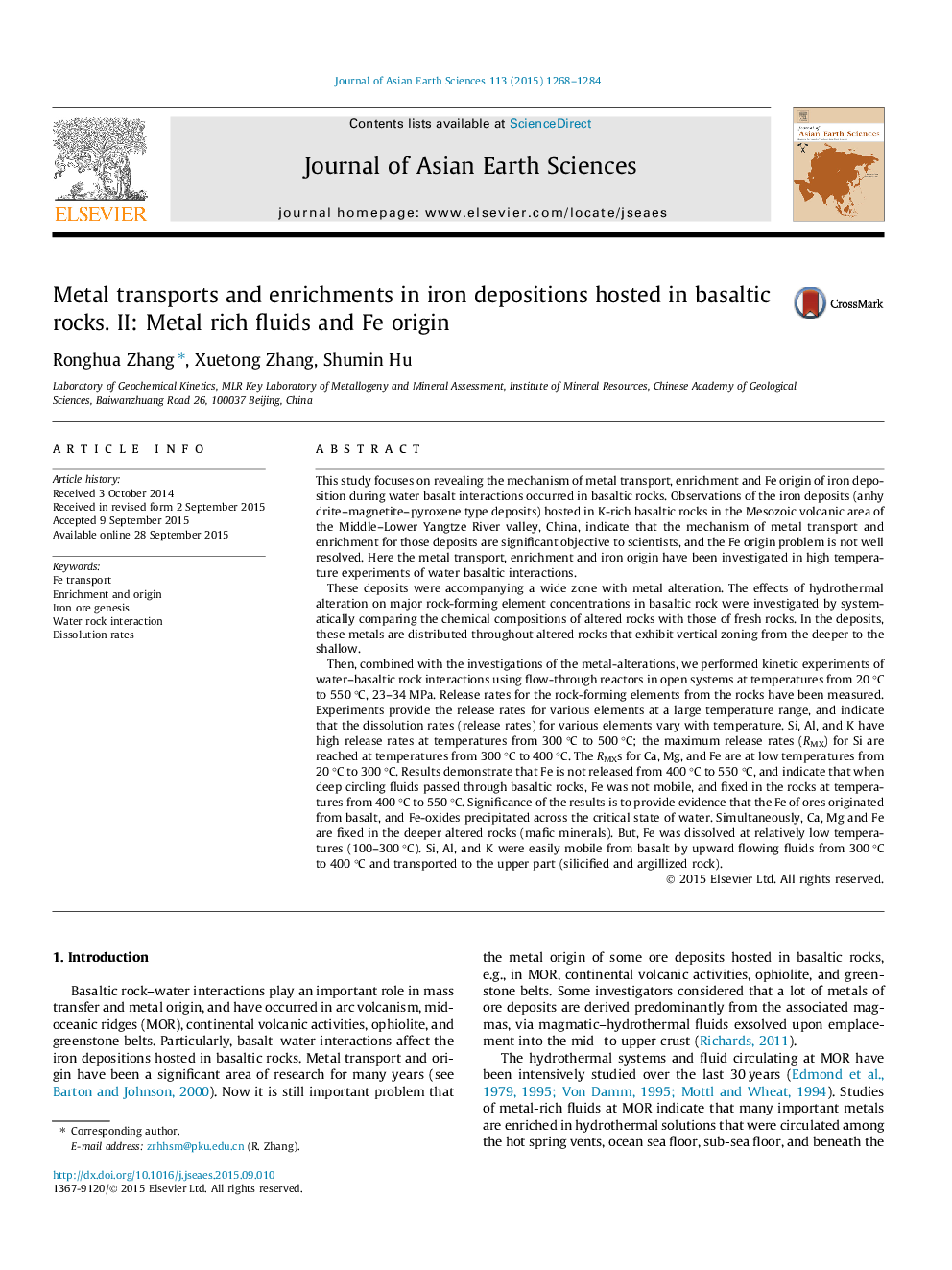| کد مقاله | کد نشریه | سال انتشار | مقاله انگلیسی | نسخه تمام متن |
|---|---|---|---|---|
| 4730291 | 1356745 | 2015 | 17 صفحه PDF | دانلود رایگان |

• Alteration zones occur in presence of temperature gradient as Fe deposition in basalts.
• Water–basalt interaction experiments at temperatures from 20 °C to 550 °C, 23–34 MPa.
• Release rates for various metals from rocks vary with temperature.
• Ca, Fe, Mg release rates are higher than Si, Al at temperature <300 °C, lower at >300 °C.
• Fe is almost unsolvable at 400–550 °C, and Fe of ores is originated from basalt.
This study focuses on revealing the mechanism of metal transport, enrichment and Fe origin of iron deposition during water basalt interactions occurred in basaltic rocks. Observations of the iron deposits (anhydrite–magnetite–pyroxene type deposits) hosted in K-rich basaltic rocks in the Mesozoic volcanic area of the Middle–Lower Yangtze River valley, China, indicate that the mechanism of metal transport and enrichment for those deposits are significant objective to scientists, and the Fe origin problem is not well resolved. Here the metal transport, enrichment and iron origin have been investigated in high temperature experiments of water basaltic interactions.These deposits were accompanying a wide zone with metal alteration. The effects of hydrothermal alteration on major rock-forming element concentrations in basaltic rock were investigated by systematically comparing the chemical compositions of altered rocks with those of fresh rocks. In the deposits, these metals are distributed throughout altered rocks that exhibit vertical zoning from the deeper to the shallow.Then, combined with the investigations of the metal-alterations, we performed kinetic experiments of water–basaltic rock interactions using flow-through reactors in open systems at temperatures from 20 °C to 550 °C, 23–34 MPa. Release rates for the rock-forming elements from the rocks have been measured. Experiments provide the release rates for various elements at a large temperature range, and indicate that the dissolution rates (release rates) for various elements vary with temperature. Si, Al, and K have high release rates at temperatures from 300 °C to 500 °C; the maximum release rates (RMX) for Si are reached at temperatures from 300 °C to 400 °C. The RMXs for Ca, Mg, and Fe are at low temperatures from 20 °C to 300 °C. Results demonstrate that Fe is not released from 400 °C to 550 °C, and indicate that when deep circling fluids passed through basaltic rocks, Fe was not mobile, and fixed in the rocks at temperatures from 400 °C to 550 °C. Significance of the results is to provide evidence that the Fe of ores originated from basalt, and Fe-oxides precipitated across the critical state of water. Simultaneously, Ca, Mg and Fe are fixed in the deeper altered rocks (mafic minerals). But, Fe was dissolved at relatively low temperatures (100–300 °C). Si, Al, and K were easily mobile from basalt by upward flowing fluids from 300 °C to 400 °C and transported to the upper part (silicified and argillized rock).
Journal: Journal of Asian Earth Sciences - Volume 113, Part 3, 1 December 2015, Pages 1268–1284